
Sunday, 13th July 2014
By Camelia Nathaniel Pictures by MegaraTegal
 The District of Mullaitivu has progressed greatly after having suffered much damage and loss of life and property during the war. Today, in spite of the trauma of the past Mullaitivu is on the road to development and reconstruction paving the way for lasting reconciliation.
The District of Mullaitivu has progressed greatly after having suffered much damage and loss of life and property during the war. Today, in spite of the trauma of the past Mullaitivu is on the road to development and reconstruction paving the way for lasting reconciliation.
The Mullaitivu district consists of Oddusuddan, Maritimepattu, Puthukkudiyiruppu, Thunnukai, Manthai East and Welioya – the only Sinhala populated area. Oddusuddan comprises 27 GramaNiladhari divisions with a population of 17,948 while Maritimepattu comprises 46 GN divisions with a population of 40,199 and Puthukkudiyiruppu has 19 GN divisions and a population of 37,045.
Thunnukai comprises 20 GN divisions with a population of 11,244 and Manthai East has 15 GN divisions and a population of 8,957 while Welioya comprises nine GN divisions with a population of 11,189. The Oddusuddan, Puthukkudiyiruppu and Maritimepattu areas had a combined population of 82,817 as at January 1, 2014.
The ethnic representation consists of three Sinhalese, 73,680 Sri Lankan Tamils, 1,222 Upcountry Tamils of Indian origin, 7,906 Muslims, and six Burghers. In the Maritimepattu, Oddusuddan and Puthukkudiyiruppu areas alone there are 1,746 ex-LTTE rehabilitated combatants, reintegrated into society while about 195 cadres who have not been rehabilitated are also residing in those areas.
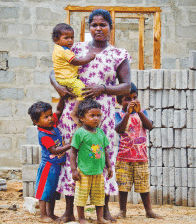
Housing and resettlement
The resettlement of displaced persons in the Oddusuddan and Keppapilavu areas commenced on February 13, 2010 and was completed by September 25, 2012. In the case of construction and renovations the Army has played a huge role by providing manpower and skilled labour in most of the areas.
In addition to the houses the resettled people also have been provided wells and sanitary facilities with the support of the Army. In spite of the many allegations by certain political parties, the Army is engaged in many projects at grassroots level where living standards and education have been their main targets and upon completion of these projects the civilian administration has been entrusted with the management of these facilities.
The Keppapilavu area was under the control of the LTTE in 1996 as there was an LTTE built runway close by. By 2009 there were 121 families living in Keppapilavu, 71 in Sooriyapuram, 32 families in Seeniyamottai, and 54 in Puthukkudiyiruppu.
The Army had been instrumental in constructing 625 transitional shelters for the displaced after the end of the war. One hundred and twelve houses that were damaged were also renovated while 271 permanent new houses were also constructed. Using its own resources, the Army constructed 15 houses, while 151 houses were built by the Army using government funds and 105 houses were constructed with the help of donors. The Army had also constructed seven drinking water wells in Keppapilavu.
Initially there were 165 families living in IDP centres in the Wanni and about 113 were displaced but living with relatives or friends. In September 2012, 162 of the IDP’s were brought to Keppapilavu but today these families have expanded to 308 families as at June 30, 2014. The government has begun constructing houses for 293 families allocating Rs 375,000 per house. However the ultimate cost of a house is estimated at Rs 700,000.
In June 2013 the construction of another 101 houses commenced and was completed in February this year. Stage three commenced in March 2014, and 227 houses plus 287 toilets were constructed. In stage four another 60 houses are to be constructed by the government, but instead of waiting for the funds to be passed, the Security Forces Commander Mullaitivu Major General Jagath Dias has instructed his men to commence construction utilizing their funds until government funds are made available.
Speaking to The Sunday Leader the 592nd Brigade Commander Colonel AmithSeneviratne, who is in charge of the construction of houses in Keppapilavu said that his aim is to complete the construction of the houses in the fourth stage by the end of the year if the weather holds.
“Eleven more tube wells and dug wells are under construction by us while the UN Habitat aid initiative is expected to donate another ten wells. Among the ongoing projects are the Construction of 142 houses at Keppapilavu model village – Stage III, Renovation/Reconstruction of 50 houses in Wellamullawikkal area and the renovation of the playground at Puthukkudiyiruppu Central Collage,” he added.
Employment
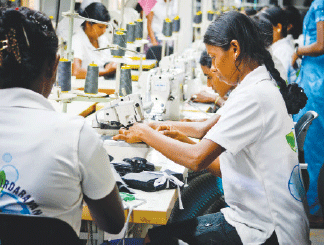
To create more employments in the Mulaithivu, ‘Hirdaramani’ apparel factory is to train a selected group of females to employ at the proposed sewing training centre.
Established in the Security Forces Headquarters-Mullaitivu (SFHQ-MLT) premises, the training centre will train 35 women in the area. Eventually the company will employ about 2000 youth. The company will operate 150 machines under the first phase and the remaining 100 by July 2015.
This is one of the many programmes initiated by the security forces to uplift living standards of the resettled community in the North. In addition to job-oriented training, self-employment training programmes are also conducted for young would-be entrepreneurs.
Speaking to The Sunday Leader the manager of the training centre S. Katheesan said that selections were made from the youngsters of the area between the age group of 18 and 24 in batches of about 35 and each batch undergoes a training period of two months.
“We have already allocated 15 acres of land to construct the factory complex in Puthukudiruppu. Construction will commence shortly and the factory will be opened by July next year.
Due to the lack of employment opportunities, especially for the youth in the North, the government had approached Hidramani apparel and requested from them to set up a factory in the Mulaithivu region.
The company has to spend Rs. 367,500 per month on salaries for the trainees who are paid a monthly allowance of Rs. 10,500. A further Rs. 144,000 is spent each month to transport the 35 trainees. Furthermore, Rs. 136,500 is allocated for their food. In addition to the salaries, two trainers are also being paid each Rs. 20,000 per month.
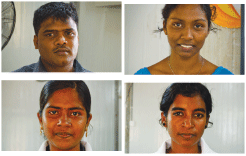
BalaratnamSabendhini (21)
I joined the training on June 19 and I am very happy having this opportunity as finding employment here is very difficult. I have three members in my family and we live in Puthukudiruppu. Our family finds it really hard to survive because finding work that pays a decent wage is a rare opportunity. Hence I am glad I got this opportunity to assist my family.
SelvamNilani (21)
I lost my father in 1996 after suffering from an illness, now I live with my mother. My older brother too disappeared during the war and my mother provides for us both by selling milk.
Before I got this opportunity I depended on my mother and I know that it was a huge burden to her. But since she loves me, she never grumbled. However, now that I have got this opportunity, I am very happy that I can take care of my mother.
Nirosha (20)
I am from Kandy and I came here to train these Tamil girls in the garment trade. Having joined the company a year and a half ago, I initially was employed at the KahatuduwaHidramani factory.
In fact, I very eagerly volunteered to come here and help these girls who are also in my age. However, one of the drawbacks was the language barrier. Other than that, we are very happy to work together and they teach me Tamil and I teach them Sinhala.
Demining

Demining in the Mullaitivu District is being carried out primarily by the Sri Lanka Army Humanitarian Demining Uunit and assisted by the Swiss Foundation for Mine Action (FSD), Mines Advisory Group (MAG Australia), HALO Trust (England), Sarvatra (India), Danish Demining Group and Delvon Assistance for Social Harmony (DASH).
The Sri Lanka Army Humanitarian Demining Unit was allocated 121 sq km of which they have completed 118 sq km and only three sq km is left to be cleared; this consists of jungle areas that have to be cleared manually. The FSD was allocated seven sq km which they have completed. HALO Trust was allocated 0.2 sq km of which they have so far completed 0.1 sq km. MAG has completed the 2.8 sq km which was allocated to them. Sarvatra too has already completed demining the 16.7 sq km that was allocated to them. DASH has so far completed 12 sq km of the 15 sq km that were allocated to them. In total 157 sq km of the total demarcated area of 163 sq km has been cleared of mines and other explosives.
Speaking to The Sunday Leader Captain Dinesh Kulasekara, the officer in charge of the demining site in Kumulamunai East said that demining commenced at this location on May 28, 2014. The estimated area to be cleared is 91,191 sq m. The total area that has been cleared manually is around 3,951 sq m. During the demining process the recovery team had recovered 51 anti personnel mines and seven unexploded ordnances (UXO).
According to Captain Kulasekara in Kumulamunai East the areas identified so far for demining are DA 587 – an area of 91,191 sq m – which is currently in progress and DA 588 spanning an area of 955,724 sq m and DA 586 which spans 113,371 sq m is yet to commence.
He further added that while there are two teams of 30 deminers each engaged in demining activities in this area, the internationally stipulated area that a deminer can cover is only around 10 sq m per day. Captain Kulasekara pointed out that the deminers are only expected to work around three hours per day and the explosives that are recovered are deactivated thereafter.
During the clearing operations the Army had also detected an underground bunker which had been used by the LTTE. “However we have still not explored the underground bunker complex as it could be heavily riddled with explosives. Therefore while there are several entrances to the underground bunker once we clear the surrounding area we will be exploring the bunker complex. Furthermore, we are not certain who used this bunker complex but perhaps Prabhakaran himself could have been here on certain occasions. As this area was occupied by the LTTE it has been heavily mined,” he added.
Meanwhile according to Lt. Col ChinthakaWickremasinghe, the Commanding Officer of the 11 Field Engineers Regiment, the demining teams also utilize the services of trained dogs to detect buried mines. However he said that while dogs are faster than humans at detecting the mines, they only can be used in open areas where there is no undergrowth. He said that while these dogs can sniff out any buried explosives up to 15 cm below the ground they too can only be worked for around three hours per day.
“We have already cleared all the residential areas in order to facilitate the resettlement of civilians while the areas that are left are thick jungle which must be cleared manually as the mine clearing machines cannot operate in thick jungle and even the dogs cannot be used in jungle areas with thick undergrowth. Taking into consideration the pattern in which the LTTE had laid the mine fields, we have determined that they would have done so in order to prevent the government troops from proceeding towards the Nandikadal lagoon,” he added.
The demining dogs have been given to Sri Lanka for demining purposes by the US institution Marshal Legacy. These dogs are trained in the US and sent to Sri Lanka. Once they train with their handlers for a further three months, they have to obtain a license from the UN certifying their capability to engage in demining activities. The dogs are only fed once a day in order to maintain proper body mass suitable for effective demining. In fact a Sri Lankan demining dog Cairo was adjudged the world’s best demining dog for 2012. The demining in Kumulamunai East has deployed six trained dogs for demining purposes, while the dogs and handlers are paired by matching their behaviour and personalities, said Sergeant Jayalal, who is part of the demining team utilizing these dogs.
Education
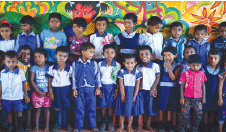
Education in the Mullaitivu region had been severely affected like in so many other areas in the North during the war. In Keppapilavu a new preschool and a primary school have been constructed in order to facilitate the educational requirements of the children who were deprived of a proper education due to the war.
Meanwhile the Army in collaboration with donors has constructed the school buildings of the UnnappilavuVidyalaya, Vannankulam Muslim Vidyalaya, Keppapilavu Tamil School, and KompavilVigneswaraVidyalaya. A further nine school playgrounds have also been constructed for the benefit of the children in Puthukkudiyiruppu Central College and Viddiyananda College Mulliyawalai.
However there is a shortage of teachers especially in the 1AB schools in Mullaitivu. For instance in Maritimepattu there are only two Arts, Commerce, Science and Math streams (1 AB), four Arts and Commerce streams, 11 schools up to O/Level and 12 schools up to grade five. In Oddusuddan one Arts, Commerce, Science and Math streams (1 AB), three Arts and Commerce streams, seven schools up to O/Level and 16 schools up to grade five. In Puthukkudiyiruppu there are two Arts, Commerce, Science and Math streams (1 AB), three Arts and Commerce streams, 11 schools up to O/Level and six schools up to grade five.
In the Maritimepattu DS Division there are 29 schools with 7,922 students and 508 teachers. In the Puthukkudiyiruppu DS Division there are 22 schools with 8,811 students and 442 teachers and in the Oddusuddan DS Division there are 27 schools with 4,038 students and 243 teachers. The student teacher ratio is 17:1 which is considered very favourable. However, only a small percentage of students study Math / Science subjects due to the lack of 1AB schools. Of the 532 students who sat for the Advanced Level examination in 2013, 305 of them had passed; 36% had passed Math, 25% had passed Science, 44% had passed Commerce and 79% had got through Arts.
First batch of Tamil recruits passed out
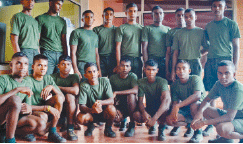
The first batch of 30 woman recruits from Mullaittivu area, passed out on Wednesday (2) amidst a colourful ceremony upon completion of their three-month long training period at the Security Force Headquarters – Mullaittivu. These woman soldiers will take up duties for civil co-ordination work.
Having successfully recruited the first ever batch of Tamil female recruits to the army in Killinochchi on March 21, 2013 and several other Tamil women in subsequent batches, the army now expects to recruit as many as 500 young tradesmen, skilled in driving, clerical work, bakery, store-keeping, cookery, welding, agriculture, carpentry, masonry, fire extinguishing, cultural performances, electric work, general duties, etc.
The first batch of Tamil boys in this regard was recruited and they are now undergoing training at the 6th SL Army Service Corps in Mulaithivu under the SF Commander Mulaithivy Major General Jagath Dias.
S. Sarangan (24)
I decided to join the army as there is no work in this area and this is a permanent job which also offers a pension after my service. I am the oldest in my family and my two younger sisters are still schooling.
I enlisted in the Vattapalan camp together with another 28 young boys and we commenced our training on June 9.
I will be trained in motor mechanic for three months and then I will employ in the field. However our training does not include weapons.
I enjoy the evening sports activities together with the other soldiers at the camp both Tamil and Sinhalese. Here there is no discrimination and even the other Sinhala soldiers have treated us very well. Joining the army will also gives me an opportunity to engage in sports activities as well.
A.M. Madhiyakalan (20)
I received my education at the Muthiyankattu MV. I am the 4th in my family of six. My oldest brother is overseas while another is in Settikulam and the rest are at home.
There is a severe shortage of employments in my village and many young people are jobless. I remember, since my childhood I always wanted to join the army. There were no LTTE activities in our village in Settikulam and as I used to see the soldiers always and it made me want to someday join them.
I have enlisted in the motor wiring course and will commence my training shortly. My ambition is to engage in my field of training for about a year and then try to pursue a career in sports in the Army as they provide excellent opportunities and facilities in sport. I play Cricket and football with the other soldiers in the evenings and hope that someday I could realise my dream.
Kumar Sugandhan (21)
I am a resident of Udayarkattu and youngest in my family. When I heard of the opportunity of joining the army, some people in our village said that it was not a good idea and discouraged me from joining. They told me that I should try and go abroad like many people are doing in our village. However having heard of the numerous trouble young men get into in seeking to go abroad and also falling prey to unscrupulous elements, I decided that joining the army was the best opportunity. However I was determined as there were no other employments in our village either.
I will be trained in house painting. After the initial three months training we will be allowed to visit home during our off days and even during the training our parents are allowed to visit us on Sundays.
I am really enjoying my time here and being with other young men has really made me understand them and their attitudes. We all work as one here and I hope we never have to go through what we had all these years, ever again.
From : http://www.thesundayleader.lk/2014/07/13/mullaitivu-on-the-road-to-recovery/




